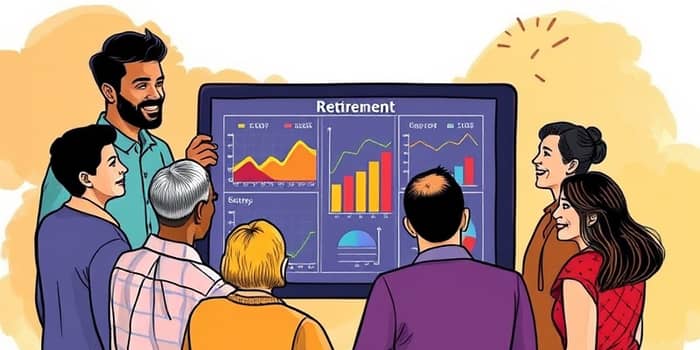Planning for retirement can feel like navigating uncharted waters without a map. Today’s retirement projection apps act as your guiding compass, offering clarity and direction so you can approach your golden years with confidence and peace of mind.
Understanding the Purpose and Benefits
Retirement planning apps are revolutionizing how individuals prepare for their later years. These digital tools empower you to estimate future income needs, identify potential shortfalls, and adjust strategies early in your career.
By harnessing sophisticated algorithms and real-world market data, you can reduce anxiety by allowing users to model different scenarios and see the long-term impact of today’s decisions on tomorrow’s lifestyle.
- Clarify how much you need to save to hit your goals
- Simulate diverse economic conditions in seconds
- Receive tailored advice based on modern financial theories
How These Apps Work
At their core, retirement projection apps ask for your personal and financial details—age, current savings, annual income, contribution amounts, and desired retirement age. With this data, they apply statistical methods to forecast your potential nest egg.
Most apps let you set or tweak assumptions for market returns, inflation, salary growth, and life expectancy. By default, many use historical averages, but you have the power to fine-tune each variable.
- Input personal details such as age, current savings, and income
- Adjust assumptions for returns, inflation, and salary growth
- Define your desired retirement age and estimated monthly expenses
- Review customized projections and probability outcomes
- Experiment with different contribution rates or investment strategies
Once configured, the app runs thousands of market scenarios using Monte Carlo simulations, delivering probability-based outcomes backed by Monte Carlo and providing you with a realistic view of how often you might reach your targeted savings.
Key Assumptions Behind Projections
Every forecast relies on assumptions. While you can customize them, it helps to understand common defaults:
Pre-retirement return rates are often set at pre-retirement return rates around 6%, reflecting a balanced portfolio of equities and bonds. During retirement, a more conservative assumption of around 5% return is used to account for lower-risk allocations.
Salary growth is typically modeled at 2% annually, which tracks average wage inflation—but you can increase this if you expect faster career progression. Expense inflation usually defaults to 3% to mirror living cost increases over time. Life expectancy assumptions extend into the mid-90s, ensuring your funds last through a long retirement.
Most calculators target an income replacement ratio of 80–85% of pre-retirement earnings, striking a balance between comfort and sustainability during retirement.
Features of Leading Retirement Apps
With so many options available, choosing the right tool depends on the features that matter most to you. Below is a comparison of six popular platforms:
Scenario Planning and Advanced Tools
Beyond simple projections, advanced apps let you compare conservative and aggressive scenarios side by side. You can model life events—home purchases, college funding, or inheritance—and assess their ripple effects on your long-term strategy.
Look for functionality such as detailed cash flow modeling, tax impact analysis, and interactive visualizations that bring your plan to life. Embracing these features delivers visual lifetime cash flow projections that update as your circumstances evolve.
- Detailed lifetime cash flow illustrations and charts
- Tax implications and break-even analyses built in
- Interactive Sankey diagrams showing income and expense flows
- Secure data storage with encryption and optional cloud sync
Real-World Use Cases
Individuals rely on projection apps to answer critical questions: How much should I save each month to retire at 67? What if I aim for early retirement at 60? By adjusting your retirement age, savings rate, or portfolio allocation, you can see new targets and strategies emerge.
Other scenarios include assessing the impact of a market downturn on nest egg longevity, factoring in a significant salary increase or career change, and comparing the effects of a lump-sum inheritance versus steady annual contributions. A detailed year-by-year breakdown shows withdrawal patterns, balance sustainability, and success probabilities for each scenario.
Expert Tips for Maximizing Your Plan
Financial professionals suggest saving at least 10–15% of pre-tax income annually, but personalized calculators refine that target based on your unique inputs. It’s crucial to revisit your plan when major life events occur—marriage, home purchase, or career changes—and to adjust for shifts in market conditions.
Focus on strategies like revisiting your plan after significant milestones, increasing contributions when you receive raises or bonuses, and rebalancing your portfolio annually to maintain your desired risk profile. By staying proactive, you ensure your projections remain relevant and that you can plan with realistic, data-driven insights that adapt as your life evolves.
Conclusion
Retirement projection apps offer a comprehensive approach to financial planning by blending robust analytics with intuitive interfaces. Whether you’re just starting your career or approaching retirement, these tools provide clarity, direction, and peace of mind.
Embrace the power of projections to test different scenarios, fine-tune your savings rate, and adjust assumptions until you feel confident about your retirement roadmap. With the right app, you can look forward to your future knowing you’ve charted a clear path, prepared for uncertainties, and secured the lifestyle you deserve.
References
- https://www.nerdwallet.com/calculator/retirement-calculator
- https://www.schwab.com/retirement-planning-tools/retirement-calculator
- https://projectionlab.com
- https://investor.vanguard.com/tools-calculators/retirement-income-calculator
- https://www.ml.com/personal-retirement-calculator.html
- https://www.dividend.com/how-to-retire/5-retirement-apps-to-help-you-hit-your-financial-goals/
- https://www.calpers.ca.gov/documents/service-retirement-election-app/download
- https://retirementcalculator.nga.finra.org










